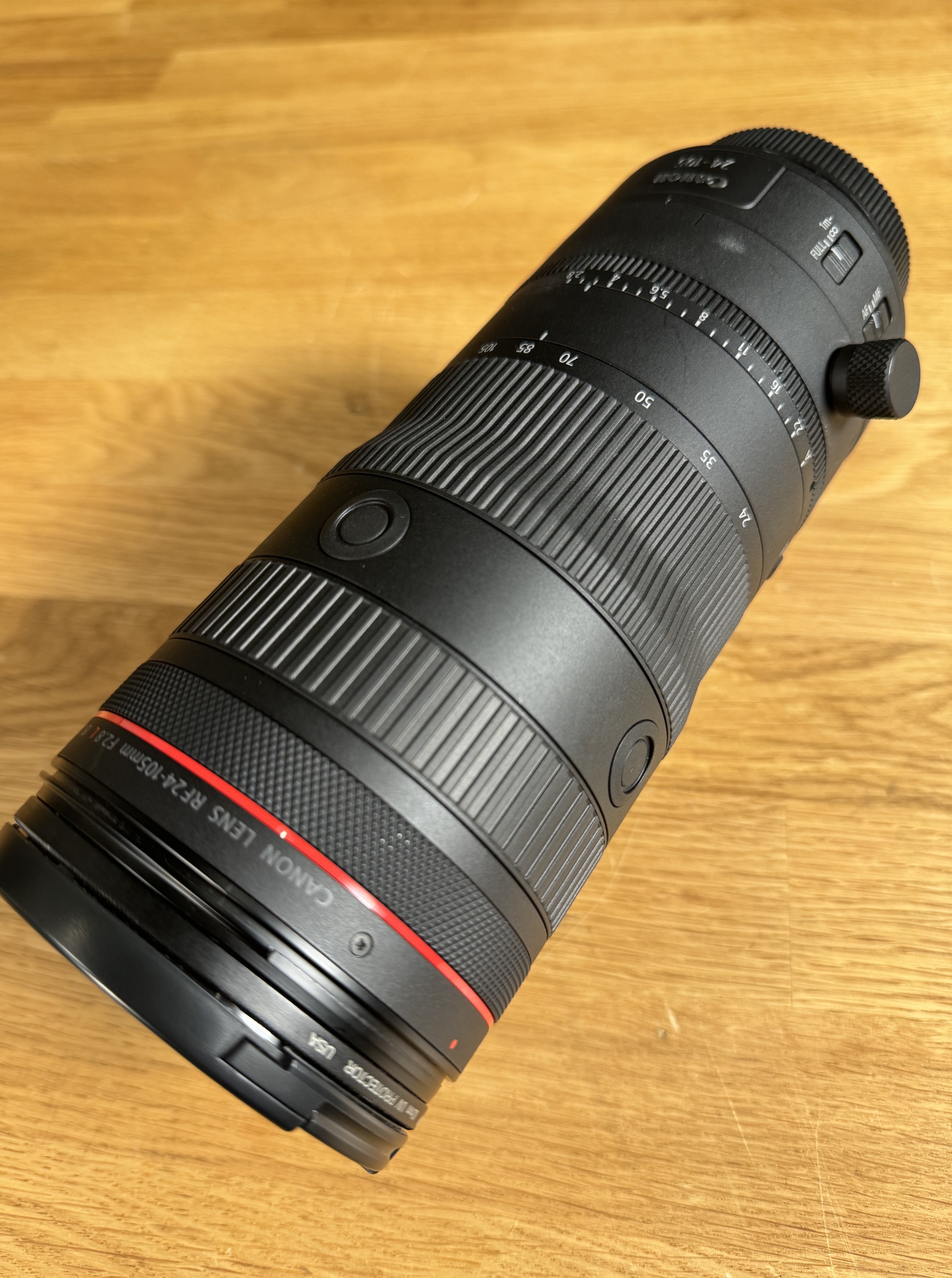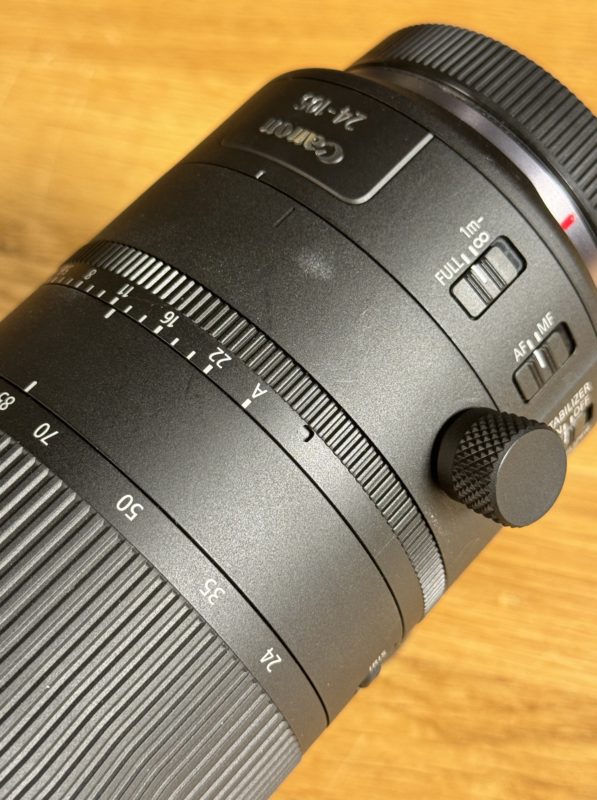
It’s an axiom in the industry that there is no perfect camera/lens/editor/computer — you get the idea. But technology has gotten us a lot closer to perfection in several regards.
Lenses are an area that has exploded over the past few years. The move toward mirrorless cameras plus the huge increase of of manufactures in the sector has generated some amazing, affordable pieces of glass.
The venerable Canon has brought a few new pieces to the market that are very interesting. The recently released RF 24-105 f/2.8 (MSRP $2999.00 USD) is one lens that caught my eye.
I shoot primarily Canon. I’ve owned almost every EOS Cinema body since the amazing C300 Mark I. My current lineup is a C300 Mark III (EF mount), two C70’s (RF mount) and an R5C (RF mount). It’s simple to fit an EF lens to a RF body via adaptor. In fact, using a Canon adaptor can make the EF lens function almost as good as a native lens on my RF bodies.
The Canon RF mount offers some advantages — better optical stabilization and great autofocus paired with sharp glass. The new mount allows the lens to be physically closer to the camera and allows some unique glass.
The primary example of this evolution is the brand new 24-105 f/2.8 RF zoom. Or to be specific, the Canon RF 24-105mm f/2.8 L IS USM Z Lens (Canon RF).
I contacted my dealer the day it was announced and reserved my copy. On Dec. 18, Santa — I mean FedEx — delivered it to my door.
The unboxing
The 24-105 f/2.8 comes with the usual accouterments — lens cap, lens hood, bag, box, instructions in way too small print and enough plastic bags to start your own recycling plant.
The first thing I noticed was the color of the lens bag. Instead of light gray like the 70-200 f/2.8 EF, the new long RF bag is black. Not a big thing but for some reason, I wasn’t expecting a change there.
The lens reminds me of the 70-200 EF in size, weight and feel. The 24-105 f/2.8 RF is 7.8 inches long (199mm) and weighs 2.9 lbs (1330g). The 70-200 f/2.8 EF is 7.75 inches (197mm) long and weighs 3.5 lbs (1590 g) — a touch longer but less weight.
What I Look For In A Lens.
A few more observations before I jump into use cases with the 24-105 f/2.8 RF. The glass is sharp, even at 2.8. The bokeh is very nice. The lens has a great look. There are a number of more detailed technical reviews out there that measure breathing, pincushion/distortion, etc. This isn’t that review.
I am looking at how the lens looks and feels in my everyday workflow and if I think it’s a good value for the money.
These days, I shop for lenses with a few questions in mind:
Will the new lens replace/improve an existing piece of gear in some way? (Range, image quality, speed)
Will the new lens work well handheld on my R5C or C70?
Will the new lens work well on a tripod-based camera?
Will the new lens work well on a slider?
Here’s what I found.
Less than a week into using the 24-105, I decided to sell my 24-70 EF f/2.8. I got this lens almost three years ago so I would have native glass on the C70s and so I could take advantage of the three-axis stabilization that the RF mount provides. It’s sharp and has great color, but I found myself not using it once I had the 24-104 in hand. The 24-70 is 4.95 inches long and weighs 1.98 lbs versus the longer (7.8 inches) and heavier (2.9 lbs) 24-105. But the extra 35mm of range was well worth these additions.
So the 24-70 f/2.8 RF got packed up and shipped to KEH.com. Thanks for your service! The answer to question No. 1 is yes, this lens replaced an existing piece of equipment I had.
I used the 24-105 handheld on both the C70 and R5C with optical stabilization on. This is the lens-provided stabilization that is activated by flipping the manual switch on the lens body. It is not the in-camera digital IS that shrinks the field of view and floats the image within the sensor to minimize shakes and jitters.
The optical stabilization didn’t make me a steadicam-like operator with no rig, but it did smooth the normal shake somewhat. Stabilizing a handheld shot zoomed in at 105 can be a challenge anyway and this lens did not eliminate all shaking. But it did make the movement smoother and maybe a little more organic. It reminded me of the doc cinema verte style of the ‘90s where everyone went Dutch angle with tripod heads and tried to master the wandering camera look.
At wider angles of 24-45/50, the optical stabilization looked great and was usable. It was nice to be able to use stabilization without losing any sensor real estate via a crop. I found myself enjoying it handheld on the R5C more than the C70.
Using the lens on a tripod and a slider
Moving the rig to a tripod and then to a slider is where the lens shined.
Many times I have wanted just a little more zoom when I hit the end of the 24-70. I also own the Canon 18-80 T4.4 zoom and find that range to be almost ideal for news conferences, speakers and any time I have to set up in the back of a room and shoot a podium talking head. Most times, I can only get a mid-podium to top-of-head shot, and I’ll punch in on the UHD picture in post.
Now with the 24-105, I can get that extra punch-in I need without giving up the ability to crash wide to get a shot of the crowd in venue. The 2.8 means I don’t have to ISO up as much as I do with 18-80 in darker environments. It’s very rare that you get an indoor press conference with correct lighting.
We do a fair amount of culinary video in our studio — product demos, recipes, kitchen techniques. We recently had a series of four recipe videos for a client that we decided to use the 24-105 on.
We paired the 24-105 with one of our Canon C70s on a Syrp slider. The intent was to grab quick cutaways of details such as ingredients being chopped, additions to cooking pans and final dish presentation.
What we found was the wide end of the lens allowed for a nice overview of the action and the zoom allowed for tight detail. Before, we would use a 24-70 then scale up the shot to 80% in post (shooting in UHD, finishing in 1080). The 24-105 allowed us the most versatility for getting the types of shot we wanted with no lens change needed. Production was quicker and smoother, and we didn’t miss a shot because we were changing glass.
The 2.8 aperture creates a nice bokeh as well. The rush to shoot wideopen has created a bokeh ascetic that almost places the whole subject out of focus. Just because you can achieve a look doesn’t mean the look serves the narrative structure. Sometimes a little bokeh goes a long way.
We found the 11 aperture blades create a nice effect, similar to other Canon f/2.8 glass. Opening to f/2.8 gave a pleasing look that allows the viewer’s eye to snap to the intended subject without losing focus. This was important in the recipe videos for things like mincing garlic and cutting vegetables. Sometimes, we stopped down to f4.0 to expand the band of focus and to match the look of the 18-80 T4.4 main shot. The two lenses intercut very well.
The autofocus was snappy and accurate. Most of the time, we shoot in focus-assist mode, which plants a box in the viewfinder that shows how close to focus you are. This lens worked really well with the assistance functions. It is a focus by wire mechanism, though.
Like all Canon RF zooms, there is a front dial on the lens that can be programmed to change ISO, aperture and a few other functions.
One of the unique things about the 24-105 f/2.8 is that Canon has added a dedicated aperture ring control on the back of the lens that allows manual iris control, much like a cinema prime. The ring control is de-clicked and smooth on the C70 but only works in video mode on the R5C. If you put the R5C in photo mode, you lose the manual control and the ring becomes useless. It would be nice if Canon allowed a firmware update to allow manual aperture control in photo mode.
For years, the Canon 24-105 f/4 has been a standard kit lens for photo and video. The range was deemed sufficient to take care of most situations. But the f/4 was a little off putting. I had version 1 of this lens years ago and sold it because I felt it was too dark for what I needed and the edge of picture was a bit soft. Versions 2 improved everything except the aperture of f/4.
Canon has created it, the next all around great lens for video.
The Canon RF 24-105 f/2.8 zoom is the next evolution of that zoom. It far outclasses the old 24-105 f/4 in almost every way. It is bigger and heavier, but the range and speed advantages outweigh the disadvantages for me.
Canon shooters often own the trinity of f/2.8 zooms — the 16-35, 25-70 and 70-200. To me, the 24-105 f/2.8 might allow a starting shooter to push off buying the 70-200 f/2.8 a bit.
The 24-105 f/2.8 is an amazing lens made possible by the physics of the RF mount and the ingenuity of the engineers at Canon. Along with the 28-70 f/2, this current development path shows that Canon has a few tricks left up their sleeve.
Bottom line — the Canon RF 24-15 f/2.8 was a great purchase for me that allowed me to directly replace a lens in my kit, offered range and speed advantages (less lens changes) and gave me advantages I didn’t have before in the way I shoot. I highly recommend.
Disclaimer: I bought this lens sight unseen. Canon didn’t provide any compensation or loan any gear for use in this review.

